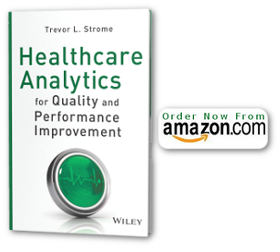In my previous article Three Key Analytics Usability Factors for Improving Healthcare, I argue that how usable analytics (such as dashboards, scorecards, reports, predictive models, and simulation tools) are will determine how likely they are to be embraced and, more importantly, used in meaningful ways to improve healthcare. That article provides a high level overview of three factors that impact the usability of analytics, which are accessibility, analysis, and presentation. This article will focus on the first of these three factors – accessibility.
Avoid generating trivia – ensure the right information is accessible
One key aspect of accessibility is ensuring that the right information is accessible. Although this seems like common sense, the phrase “drowning in data but information starved” seems to be applicable now more than ever. Three aspects of ensuring that the right information is accessible are relevancy, organization, and timeliness.
1. Relevancy -Information must be relevant to current and pressing problems facing a healthcare organization (HCO) to be useful; otherwise it is mere trivia. Reams of unrelated data, reports, and other information will be of much less valuable than a relative few performance indicators that measure key aspects of an organization’s performance – especially related to improvement initiatives. (See here for a recent article on key performance indicators).
Ensure that analytics are aligned with the information requirements of ongoing improvement initiatives and strategic goals of the organization.
2. Organization – Even if your organization has developed analytics and business intelligence applications that focus on key performance indicators that are highly relevant to improvement efforts, that information will not be used if end-users are unable to find it. Most business intelligence suites provide a “portal” functionality. However, in many (if not most) HCOs, these portals become merely a collection of reports and miscellaneous tools aggregated over time – far from a strategic information resource.
Information must be easy for decision makers and other users to access without digging through dozens (if not hundreds) of reports and endless layers of poorly named folders. Likewise, key information should not be force-fit into crowded dashboards that attempt to display every indicator on the same screen. Intuitive contextual browsing, simple navigation, and well-designed dashboards are hallmarks of well-organized analytics that make information easy to find.
3. Timeliness – The first aspect of timeliness is common-sense; how up-to-date is the data used by the analytics tools to generate useful information. For example, dashboards that are not updated in real-time (or near real-time) are simply not valuable to decision-makers who are proactively working to enhance patient flow and improve quality. If information is out-of-date, it is simply not the right information.
The other aspect of timeliness is how current the analytics tools are themselves. Source data and business processes are dynamic, changing over time, so algorithms contained within analytics applications need to be constantly updated to reflect current realities. It is important not to put analytics on “auto-pilot”; most analytics need to be monitored and tweaked regularly to account for changes in the environment.
The bottom line is that accessibility is all about removing barriers between people and the information they need to make decisions. My next articles on accessibility and usability will focus on ensuring that the right people have access to analytics, and on how deployment options impact usability.

{ 0 comments… add one now }
{ 1 trackback }